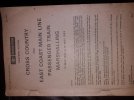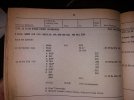I think I've seen trains with two BSK/BFK/BCK - were there included as well as or instead of BG?
Thinking of your own geography 'Inversnecky', one interesting curiosity in Scotland was for some reason the Scottish region did not originally have an allocation of BGs and whilst many BGs were used in Scotland on both passenger and parcels trains they were predominantly those carrying the M prefix plus quite a few E. Very occasionally an example with W would appear.
In Mk1 days on passenger trains BGs were mainly used on the Far North and Kyle lines and between Edinburgh and Aberdeen plus on the overnights - Edinburgh/Glasgow to/from Inverness, Perth to Aberdeen and Glasgow to Oban, the latter two only being overnight in the northbound direction. Also one BG on the evening Glasgow to Mallaig and morning return.
Glasgow to Aberdeen sets had a BSK on the south end and BSO at the north end with any strengthening vehicles outside the BSO, and likewise Glasgow and Edinburgh to Inverness (or sometimes BSK on either end), whilst the combined morning northbound and afternoon southbound also had a BCK in the Edinburgh portion, and southbound conveyed the BG (and TPO vehicle) which had worked north on the mail from Perth that morning.
Glasgow to Dundee sets also had the BSK and BSO combination although latterly BFKs began to replace the BSK (and adjacent CK or FK) and they then started to run with only one brake vehicle - always on the south end due to the instruction that banking was compulsory for departures from Queen St if the rear vehicle did not have brake compartment (in which the Guard must ride). Edinburgh to Dundee was still DMU at this time, as was Glasgow to Stranraer and via GSW to Carlisle (other than the trains towards Leeds) which later went over to Mk1 operation.
I think by the time Inverness - Aberdeen went over to loco haulage BGs with Sc prefix were beginning to appear on these and other services and cascaded Mk2s were coming to the fore on the other services although often with a BSO (or BFK) on either end although gradually this dropped to a single brake vehicle on many services although it would be quite common find a BSO substituting for an absent TSO.
Another marshalling curiosity was whilst Glasgow to Aberdeen and Inverness (and the latter also from Edinburgh) had the catering vehicle off centre and immediately in front of the first class, between Edinbugh and Aberdeen the catering vehicle was always on the south end of the formation (with sometimes one vehicle outside it), next to but 'outside' the first class. The reason for this was whilst on all of the other internal ScR services the catering vehicle stayed with the set all day, the Edinburgh Aberdeen catering vehicles were shunted on and off the sets to also provide catering on the north and southbound Aberdeen sleepers.
EDIT: I should add the above comments apply only to internal ScR workings, most inter regional workings conveyed at least one BG generally of the parent region of the stock.
The Plymouth-Scotland sleeper via the WCML was a very long train, and divided at Carstairs.
Much of it was parcels/mail as well as sleepers and day coaches, but it managed to get up the Lickey and the fells (pre-wiring) OK.
It normally took a banker on Lickey although there may have been occasions when it crawled up without.
The WCML gradients are not as severe as on the Highland Main line where similar sized trains ran each night albeit on significantly slower timings than the lighter daytime trains.
EDIT: On checking, prior to electrification it was 'only' load 14 - still a big train, and increasing to load 16 with electrification although the date of that change to increase sleeper capacity may just have been co-incidental.
It only extended beyond Bristol to Plymouth in the 1980s.
The layout at Carstairs, plus having two shunters on duty to deal with splitting/joining and dealing with the loco for the Edinburgh portion plus brake tests, made for a very slick operation there.


